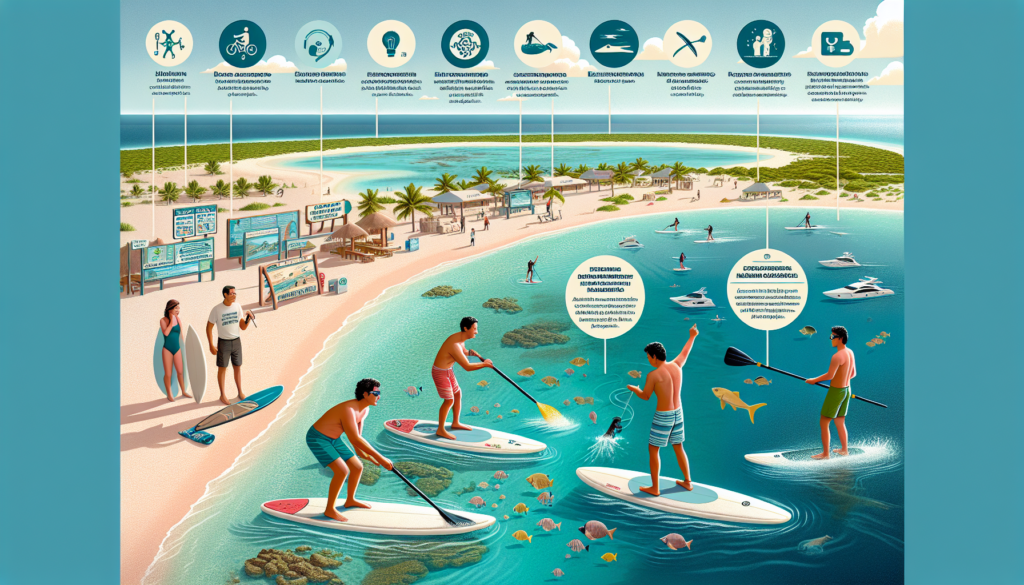If you’re a water sports enthusiast who also cares deeply about the environment, then you’re in luck! In this article, we will provide you with a helpful guide on how to enjoy eco-friendly water sports on Mexico’s beautiful beaches. From surfing and kayaking to snorkeling and paddleboarding, we will share tips and tricks on how to minimize your impact on the marine ecosystem while still having a fantastic time. So grab your gear, get ready to dive in, and let’s explore the world of eco-friendly water sports together!

Surfing
Surfing is a popular water sport that allows you to ride the waves and enjoy the beauty of the ocean. However, it’s important to practice eco-friendly habits while surfing to ensure the long-term health and preservation of the ocean. One way to do this is by choosing surfboards made with eco-friendly materials. Traditional surfboards are often made with toxic materials such as fiberglass, foam, and resin, which can harm the environment and marine life. Instead, opt for surfboards made with sustainable materials like bamboo, cork, or recycled materials.
Another eco-friendly practice is to use natural wax for your surfboard. Traditional surf waxes are made with petrochemical ingredients that can pollute the water when they wash off your board. Natural waxes, on the other hand, are made with plant-based ingredients and are biodegradable. They provide the same grip and traction for your surfboard without harming the environment.
Practicing surf etiquette is also crucial for protecting the ocean. This means respecting the rights of other surfers, following the lineup rules, and giving right of way to the person closest to the breaking wave. By practicing surf etiquette, you can avoid collisions and create a safer and more enjoyable surfing experience for everyone.
Supporting local surf schools and organizations is another way to promote eco-friendly surfing. Many surf schools and organizations have initiatives aimed at protecting the ocean and educating surfers about the importance of sustainability. By taking surf lessons from these environmentally conscious instructors, you can learn about the local ecosystem, surf responsibly, and contribute to marine conservation efforts.
Participating in beach cleanups is an essential practice for any eco-conscious surfer. It’s disheartening to see trash and debris littering the beach and floating in the water while you’re out enjoying the waves. By joining beach cleanups, you can help remove plastic waste and other pollutants from the ocean, making it a cleaner and safer environment for marine life.
Another eco-friendly habit to adopt while surfing is using reef-safe sunscreen. Traditional sunscreens contain harmful chemicals that can bleach and damage coral reefs. Choose sunscreens labeled as “reef safe” or “ocean friendly” to protect your skin without harming the underwater ecosystem.
Respecting marine life and avoiding disturbances is also essential when surfing. While it may be tempting to touch or approach marine animals, it’s important to remember that they are wild creatures that need their space. Keep a safe distance and observe them from afar to minimize stress and disruptions to their natural behavior.
Taking surf lessons from environmentally conscious instructors is beneficial for both beginners and experienced surfers. These instructors will not only teach you proper surfing techniques but also educate you about the importance of protecting the environment and practicing sustainable surfing habits.
Using eco-friendly surfboard fins is another way to reduce your environmental footprint. Traditional surfboard fins are often made with plastic, which contributes to the problem of ocean pollution. Look for fins made with sustainable materials such as bamboo, fiberglass, or recycled materials to minimize your impact on the environment.
Lastly, consider contributing to marine conservation initiatives. There are many organizations dedicated to protecting the ocean and its inhabitants. Whether it’s through donating, volunteering, or participating in awareness campaigns, every effort counts in preserving the beauty and biodiversity of the marine ecosystem.
Snorkeling
Snorkeling is a fantastic way to explore the underwater world and witness the diverse marine life that Mexico’s beaches have to offer. To ensure you have an eco-friendly snorkeling experience, there are several practices and guidelines to follow.
Before heading out, choose snorkeling sites with minimal impact. Some areas may be more vulnerable to damage than others, such as coral reefs or seagrass beds. Avoid snorkeling directly over these sensitive areas to prevent accidental damage. Research and consult local guides to find snorkeling spots that are known to have a lower ecological impact.
When snorkeling, be careful not to step or stand on coral reefs. Coral reefs are fragile ecosystems that take years to form, and touching or standing on them can cause irreversible damage. Stay aware of your surroundings and maintain a safe distance from the coral to admire their beauty without harming them.
Use biodegradable sunscreen to protect yourself and the coral reef. Traditional sunscreens contain harmful chemicals that can bleach and damage coral. Opt for sunscreen labeled as “reef safe” or “ocean friendly” to minimize your impact on the marine environment while still protecting your skin from the sun’s harmful rays.
Follow responsible marine wildlife viewing guidelines while snorkeling. Observe marine animals from a distance and avoid touching or chasing them. It’s important to remember that you are a guest in their natural habitat, and interfering with their behavior can cause stress and disrupt their natural patterns.
If you enjoy underwater photography while snorkeling, be mindful not to touch or disturb marine life in the process. Keep a safe distance and use zoom lenses to capture beautiful shots without causing harm. Respect their space and remember that their well-being is more important than capturing the perfect photo.
Participating in coral reef restoration projects is a rewarding way to give back to the underwater world. Many organizations and resorts offer opportunities for volunteers to help restore damaged or degraded coral reefs. By actively engaging in these projects, you can contribute to the recovery and growth of these essential marine ecosystems.
Using eco-friendly snorkeling gear is another way to minimize your impact. Look for snorkels, masks, and fins made with sustainable materials such as recycled plastic or natural rubber. These options help reduce plastic waste and promote more sustainable practices in the snorkeling industry.
Leave no trace and pick up any trash encountered during your snorkeling adventures. It’s disheartening to see plastic bottles, fishing gear, and other debris floating in the water or littering the beach. Carry a small bag or net with you to collect any trash you come across, ensuring that it doesn’t harm marine life or contribute to pollution.
Be aware of local regulations and protected areas. Some snorkeling sites may have specific rules to preserve sensitive habitats or protect endangered species. Take the time to learn about these regulations before visiting, and make sure to respect and follow them to minimize your impact.
Support eco-conscious snorkeling tour operators who prioritize sustainability and environmental stewardship. These operators often have practices in place to minimize their ecological footprint, such as using fuel-efficient boats, training their guides in responsible diving techniques, and supporting local conservation initiatives. By choosing these operators, you can be confident that your snorkeling experience aligns with your eco-friendly values.

Kayaking
Kayaking allows you to explore the beauty of Mexico’s coastal areas while enjoying a peaceful and environmentally friendly activity. To ensure your kayaking adventures align with eco-friendly principles, here are some tips to follow.
When renting or using kayaks, opt for ones made from recycled materials. Many kayak rental companies now offer kayaks made from recycled plastic, which helps reduce the demand for new plastic production. By choosing these eco-friendly options, you contribute to the circular economy and support sustainable practices.
Respecting wildlife habitats is crucial while kayaking. Avoid approaching nesting or resting birds, as they may be easily startled and abandon their nests. Keep a safe distance and use binoculars to observe them from afar. Remember, maintaining a minimal impact on their habitat is essential for their survival.
Choose biodegradable and eco-friendly cleansing products for your kayak. When cleaning your kayak, opt for environmentally friendly soaps and cleansers that won’t harm aquatic life when they wash into the water. Look for products labeled as biodegradable and safe for the environment.
Avoid entering sensitive ecological areas by kayak. Some regions may have protected areas or fragile ecosystems where kayaking is restricted. Do thorough research or consult local guides to ensure you paddle in permitted areas, respecting any restrictions that are in place to safeguard these vulnerable habitats.
Support local conservation efforts by participating in kayaking tours organized by environmentally conscious operators. These operators often have initiatives to protect the environment, such as educating kayakers about marine life, promoting sustainable practices, and donating a portion of their profits to conservation organizations. By joining these tours, you not only have a memorable kayaking experience but also contribute to environmental preservation.
Bringing reusable water bottles and avoiding single-use plastics is essential while kayaking. Plastic bottles, bags, and other disposable items contribute to pollution and harm marine life. Instead, pack a durable and reusable water bottle that you can refill throughout your kayaking journey. Opt for reusable containers for snacks and meals as well.
Take care not to disturb nesting or resting birds while kayaking. Birds often use coastal areas as nesting sites, and their eggs and young are vulnerable to disturbances. Respect their space and avoid getting too close to their nests. Paddling quietly and slowly can help prevent unnecessary stress and disruptions.
Participate in kayak beach cleanups to contribute to the cleanliness of the shoreline. Large amounts of plastic waste and other debris accumulate on beaches, posing a threat to marine life. Organize or join kayak beach cleanups to remove trash from the coastline and prevent it from entering the ocean.
Follow safety guidelines and wear life jackets while kayaking. Safety should always be a priority to ensure a fun and secure kayaking experience. Always wear a properly fitted life jacket and familiarize yourself with kayaking safety techniques, such as how to rescue yourself or others in case of an emergency.
Explore mangrove ecosystems responsibly. Mangroves are important coastal habitats that support a rich diversity of plant and animal species. When kayaking through mangrove forests, be mindful of the delicate root systems and avoid damaging them. Stick to designated waterways and avoid disturbing nesting or feeding areas of wildlife in these unique ecosystems.
Stand-Up Paddleboarding (SUP)
Stand-Up Paddleboarding, or SUP, has gained popularity as a versatile and enjoyable water sport. To make your SUP experience more eco-friendly, consider the following tips:
Using inflatable SUP boards is a great way to reduce your environmental impact. Inflatable boards are made from durable materials and can be easily deflated and packed into a compact size, minimizing storage and transportation requirements. This also reduces the need for new materials when compared to traditional hardboard SUPs.
Choose SUP boards made from sustainable materials. Many companies now produce SUP boards using eco-friendly materials such as bamboo, cork, or recycled materials. These options minimize the use of non-renewable resources and contribute to a more sustainable SUP industry.
When paddling, stick to designated SUP areas to ensure the safety and enjoyment of both swimmers and paddlers. Venturing into swimming areas can pose a risk of accidents and collisions. By respecting these designated areas, you can promote a harmonious environment for all beachgoers.
Using eco-friendly leashes and accessories is another way to minimize your environmental impact while SUPing. Look for leashes and accessories made from sustainable materials like recycled polyester or natural fibers. By opting for these eco-friendly options, you can contribute to reducing plastic waste in our oceans.
Avoid SUPing during sensitive wildlife breeding seasons. Many coastal areas serve as nesting sites for birds and other wildlife during certain times of the year. SUPing near these areas can unintentionally disrupt their breeding and nesting activities. Educate yourself about the local wildlife and avoid paddling in sensitive areas during breeding seasons.
Practicing proper SUP disposal and recycling is crucial for minimizing waste. When your SUP board reaches the end of its life cycle, make sure to dispose of it responsibly. Research local recycling options or consider repurposing it for another use. Avoid disposing of it in landfills or natural environments.
Participating in SUP racing events that promote environmental awareness is a great way to combine your passion for SUPing with environmental activism. These events often raise awareness about marine conservation, sustainable practices, and encourage participants to take action in protecting our oceans and waterways.
Support SUP rental companies with eco-friendly practices. Some rental companies prioritize sustainability by using eco-friendly cleaning products, providing reusable water bottles, and promoting responsible SUPing. By choosing these companies, you can align your SUP experience with your eco-friendly values.
Clean up any trash found while paddling. Keep a small bag or net on your SUP board to collect any litter you come across during your paddle. This simple act can prevent trash from entering the ocean and harming marine life, while also setting a positive example for others.
Educate others about the importance of eco-friendly SUPing. Spread the word about sustainable practices and their impact on the environment. Share your knowledge and experiences with friends, family, and fellow paddlers to inspire them to adopt eco-friendly habits as well.

Scuba Diving
Scuba diving is an incredible way to explore the underwater world and observe marine life up close. To ensure that your diving experience is eco-friendly, there are several practices to keep in mind.
Choose eco-friendly dive operators with sustainable practices. Research and select operators that prioritize environmental conservation, such as using energy-efficient boats, implementing waste management systems, and supporting local marine conservation efforts. By diving with these operators, you can contribute to the protection of marine ecosystems.
Practice proper buoyancy control to minimize damage to coral reefs. When diving, maintain neutral buoyancy, which means neither sinking nor floating, to avoid accidentally touching or damaging coral. Mastering buoyancy control allows you to glide effortlessly over the reef while minimizing any physical impacts.
Use eco-friendly diving equipment and gear. Look for equipment made with sustainable materials and choose options that have been certified for their environmental performance. This includes using wetsuits made from recycled materials, eco-friendly neoprene alternatives, and regulators made from recycled or recyclable materials.
Participate in underwater cleanups and debris removal. Many dive centers and organizations organize regular underwater cleanups to remove trash and debris from dive sites. Take part in these initiatives to help preserve the beauty of underwater ecosystems and protect marine life from the dangers of pollution.
Avoid touching or harassing marine life while diving. It’s essential to respect marine animals and their natural behaviors. Refrain from handling or chasing marine life, as this can cause stress, injuries, or even death. Observe marine creatures from a safe distance and enjoy their beauty without disrupting their lives.
Respect depth limits and dive site regulations. Depth limits are set for the safety of divers and the preservation of underwater habitats. Exceeding depth limits can put divers at risk and also damage fragile marine ecosystems. Ensure you are aware of the regulations and guidelines specific to the dive sites you visit.
Support marine conservation organizations through diving trips. Many diving resorts and organizations work closely with marine conservation organizations to fund research, protection, and restoration initiatives. By choosing to dive with these operators, you directly contribute to these conservation efforts.
Choose dive sites with healthy coral reefs and diverse marine life. Research and select dive sites that are known for their thriving ecosystems. These sites tend to have higher biodiversity and provide a more enriching diving experience. By supporting these sites, you indirectly contribute to their preservation.
Follow responsible diver behavior to minimize your environmental impact. This includes not feeding or touching marine life, avoiding kicking up sand or sediment, and securing gear to prevent unintentional damage. By practicing responsible behavior, you can help preserve the delicate balance of marine ecosystems.
Promote underwater photography without disturbing marine habitats. Underwater photography is a popular activity among divers, but it’s essential to do it responsibly. Avoid touching or moving marine life for the sake of the perfect shot. Instead, focus on capturing the beauty of marine creatures in their natural environment without causing harm.
Jet Skiing
Jet skiing is a thrilling water sport that, when done responsibly, can still align with eco-friendly practices. Here are some tips to make your jet skiing experience more sustainable:
Use eco-friendly and fuel-efficient jet skis. Newer models of jet skis are designed to be more fuel-efficient and emit fewer harmful pollutants. Opt for models with a four-stroke engine, which is known for its lower emissions and better fuel economy compared to older two-stroke engines.
Avoid high-speed maneuvers near marine mammals. When encountering marine mammals such as dolphins or whales, it’s crucial to maintain a safe distance and avoid sudden or aggressive movements. These animals are sensitive to disturbances, and your actions can impact their behavior and well-being.
Practice responsible refueling and spill prevention. When refueling your jet ski, be mindful not to spill any fuel or oil into the water. Spilled fuel can have harmful effects on marine life and pollute the surrounding environment. Take your time and handle the refueling process carefully.
Support local regulations and protected areas for jet skiing. Familiarize yourself with local regulations and laws regarding jet skiing. Some areas may have restrictions or designated zones to protect sensitive habitats or mitigate noise pollution. Complying with these regulations is crucial for preserving the natural environment and maintaining the recreational balance.
Participate in jet ski cleanups to remove oil and debris. Organize or join jet ski cleanup events to collect oil spills, litter, and other debris from the water. These initiatives help prevent pollution and protect marine life from the harms of human-created waste.
Use environmentally friendly 2-stroke and 4-stroke oils for your jet ski. Choosing oils labeled as eco-friendly or biodegradable ensures that if any oil does enter the water, it will break down naturally without causing long-term harm to the marine environment.
Avoid sensitive habitats and underwater vegetation. Be cautious of where you operate your jet ski and avoid shallow water areas with seagrass beds, coral reefs, or other vulnerable habitats. The propeller of a jet ski can cause significant damage to delicate ecosystems, so it’s important to stay in open water or designated areas.
Minimize noise pollution by reducing idle time. Excessive noise from jet skis can disrupt marine life and disturb other beachgoers. Minimize idle time by shutting off your engine when not in motion. This reduces noise pollution and conserves fuel.
Wear appropriate safety gear and life jackets. Safety should always be a priority when engaging in water sports. Wear a life jacket and other appropriate safety gear to ensure your personal safety and the safety of others around you.
Educate fellow jet skiers about eco-friendly water sports practices. Share your knowledge and enthusiasm for eco-friendly water sports with other jet skiers. By promoting sustainable practices within the community, you can help raise awareness and inspire others to adopt eco-friendly habits.

Fishing
Fishing is a popular recreational activity that, when practiced responsibly, can have minimal impact on fish populations and the environment. Here are some tips for eco-friendly fishing:
Choose sustainable fishing practices and techniques. Follow guidelines and regulations specific to your fishing location to ensure that you are targeting and catching fish in a sustainable manner. Avoid overfishing or harvesting vulnerable species, and release undersized or unwanted fish properly and safely.
Follow size and catch limits to preserve fish populations. Size and catch limits are established to help maintain healthy and sustainable fish populations. Know the regulations for the species you plan to fish and adhere to the limits set by local authorities.
Release unwanted or undersized fish properly and safely. If you catch a fish that you don’t intend to keep or that doesn’t meet the legal size requirements, handle it with care and release it in a way that maximizes its chance of survival. Use barbless hooks and minimize the time the fish is out of the water.
Use biodegradable fishing gear and materials. Traditional fishing gear, such as nets and fishing lines, can contribute to pollution when lost or discarded in the water. Opt for biodegradable alternatives made from natural materials like hemp or jute, which break down over time without harming marine life or the environment.
Support catch-and-release fishing tournaments. Catch-and-release tournaments promote sustainable fishing practices by encouraging the release of caught fish. These tournaments often have strict rules and guidelines in place to ensure the fish are handled properly and released unharmed.
Avoid fishing in protected or restricted areas. Many coastal regions have protected marine areas or restricted fishing zones aimed at preserving biodiversity and allowing fish populations to thrive. Respect these areas and avoid fishing in them to support the preservation of marine ecosystems.
Participate in fishing net cleanups to prevent marine entanglements. Old fishing nets and gear left in the water can continue to catch fish and other marine animals, leading to unnecessary suffering and death. Volunteer for fishing net cleanups to remove these hazards and prevent entanglements.
Join eco-friendly fishing charters and tours. Many fishing charters and tour operators now prioritize sustainability. These operators often use eco-friendly practices, such as catch-and-release policies, responsible fishing techniques, and supporting local marine conservation initiatives. By choosing these operators, you can enjoy your fishing experience while supporting sustainable practices.
Learn about local fish species and conservation efforts. Educate yourself about the fish species found in the area you plan to fish and any ongoing conservation efforts. Understanding the life cycles and ecological roles of different species can help you make better-informed decisions and support conservation measures.
Advocate for responsible fishing practices within the fishing community. Share your knowledge and passion for sustainable fishing with fellow anglers. Encourage discussions about responsible fishing practices, catch limits, and the importance of conserving fish populations. By promoting responsible practices within the fishing community, you can contribute to a more sustainable future.
Windsurfing
Windsurfing combines the excitement of sailing and surfing, allowing you to gracefully glide across the water with the wind as your power source. To make your windsurfing experience more eco-friendly, consider the following tips:
Choose windsurfing equipment made from sustainable materials. Many windsurfing manufacturers now offer boards, sails, and accessories made with sustainable materials such as natural fibers, recycled materials, or bio-based composites. By supporting these eco-friendly products, you contribute to a more sustainable windsurfing industry.
Maintain and repair your equipment to prolong its lifespan. Regular maintenance and repairs can extend the life of your windsurfing equipment, reducing the need for new replacements. Take care of your gear, fix minor damages promptly, and store it properly when not in use to maximize its longevity.
Avoid windsurfing during bird migration periods. Many coastal areas serve as stopover points for migrating birds during their long journeys. To prevent disturbances and minimize any negative impact on their journey, avoid windsurfing during their migration periods. Familiarize yourself with local bird migration patterns to plan your windsurfing activities accordingly.
Use eco-friendly windsurfing harnesses and accessories. Look for harnesses and other accessories made with sustainable materials such as recycled or renewable resources. These eco-friendly options contribute to reducing the environmental impact of the windsurfing industry.
Participate in windsurfing competitions focused on environmental awareness. Many windsurfing competitions now incorporate environmental education and initiatives into their events. By joining these competitions, you can support the promotion of environmental awareness within the windsurfing community and inspire more sustainable practices.
Support local windriders associations and initiatives. Windriders associations often work toward promoting the sport of windsurfing and protecting the natural areas where it takes place. By becoming a member or actively participating in their initiatives, you can contribute to their efforts in preserving and maintaining windsurfing resources.
Avoid littering by securing personal belongings during windsurfing. Secure your personal belongings, such as water bottles or snack wrappers, to prevent them from falling into the water during windsurfing. By practicing good habits and preventing littering, you contribute to a cleaner and safer aquatic environment.
Follow proper waste management practices at windsurfing spots. Dispose of any trash or waste in designated containers provided at windsurfing locations. If no containers are available, take your trash with you until you find an appropriate place to dispose of it. Leave no trace and leave the beach or windsurfing area as clean as or cleaner than when you arrived.
Use renewable energy sources for windsurfing gear production. Certain manufacturers have adopted renewable energy sources such as solar or wind power to manufacture windsurfing gear. Choose products from companies committed to reducing their carbon footprint and supporting sustainable energy alternatives.
Promote the use of eco-friendly windsurfing techniques. Learn about and share information on sustainable windsurfing practices. This includes using wind power efficiently, avoiding unnecessary motorized boat assistance, and actively engaging in responsible behavior on the water. By promoting these practices, you help create a culture of eco-conscious windsurfing.

Paddleboarding
Paddleboarding is a versatile and accessible water sport that provides a unique way to explore Mexico’s beaches and coastal areas. To paddleboard sustainably, consider the following tips:
Choose paddleboards made from sustainable materials. Many paddleboard manufacturers now offer boards made with sustainable materials such as bamboo, cork, or recycled materials. These eco-friendly options provide the same performance while reducing their impact on the environment.
Practicing proper paddle techniques is essential to minimize disturbance to aquatic life. When paddling, avoid dragging your paddle or hitting it against the water’s surface. The noise and vibrations caused by improper technique can startle or stress marine life. Opt for smooth and quiet strokes to maintain a peaceful and non-disruptive paddling experience.
Use eco-friendly and non-toxic paddleboard cleaners. When cleaning your paddleboard, choose environmentally friendly cleaning products that won’t harm the aquatic environment. Look for biodegradable and non-toxic cleaners that are safe for both your paddleboard and the surrounding water.
Participate in paddleboard races that support environmental causes. Many paddleboard races and events dedicate their efforts to raising awareness and funds for environmental organizations and initiatives. By participating in these events, you can combine your love for paddleboarding with supporting worthwhile environmental causes.
Avoid paddleboarding in prohibited areas or sensitive habitats. Some coastal areas may have protected zones or regulations in place to safeguard vulnerable ecosystems or wildlife. Respecting these restrictions is crucial for avoiding damage to fragile habitats and ensuring the conservation of marine life.
Support local paddleboarding clubs and initiatives. Paddleboarding clubs often organize cleanups, community events, and educational programs focused on environmental protection and conservation. Get involved in these initiatives to connect with like-minded individuals and contribute to local sustainability efforts.
Use biodegradable leash attachments and accessories. Secure your paddleboard with leashes made from biodegradable materials to minimize your environmental impact. These leashes break down naturally over time without leaving behind harmful pollutants in the water.
Educate others about the importance of paddleboarding sustainably. Share your knowledge and experiences with friends, family, and fellow paddleboarders. By spreading awareness of eco-friendly paddleboarding practices and the importance of protecting our coastal ecosystems, you can inspire others to adopt sustainable habits.
Avoid excessive noise pollution during paddleboarding. Enjoy the quiet tranquility of paddleboarding without disrupting the natural soundscape. By paddling smoothly and minimizing unnecessary noise, you can enhance your own experience while minimizing disturbances to marine life and other beachgoers.
Paddle in areas with calm water and low visibility to protect fragile ecosystems. Highly disturbed water or areas with poor visibility can be challenging for marine life to thrive. Choose paddleboarding locations that have calm water conditions and good visibility to preserve fragile ecosystems and enhance your paddleboarding experience.
Sailing
Sailing provides a unique experience to navigate the waters while harnessing the power of the wind. To make your sailing adventures eco-friendly, consider the following tips:
Choose sailboats with eco-friendly propulsion systems. Some sailboats are equipped with alternative propulsion systems, such as electric motors or hybrid engines. These systems reduce the reliance on traditional fossil fuels, resulting in lower emissions and a smaller carbon footprint.
Reduce fuel consumption by harnessing wind power. The essence of sailing lies in utilizing the wind to propel the boat forward. By adjusting the sails to take advantage of the wind’s direction and strength, you can minimize the use of engines and reduce fuel consumption.
Use sustainable and biodegradable cleaning products for sailboats. When cleaning your sailboat, opt for eco-friendly and biodegradable cleaning products. By doing so, you can minimize water pollution and avoid introducing harmful chemicals into the marine environment.
Support sailing organizations focused on marine conservation. Many sailing organizations actively engage in marine conservation efforts, support research projects, and promote sustainable practices within the sailing community. By joining or supporting these organizations, you contribute to the protection and preservation of marine ecosystems.
Avoid littering and properly dispose of waste on sailboats. Dispose of waste and trash in designated containers or bring them back to shore for proper disposal. Leaving trash on the sailboat or throwing it into the water can harm marine life and contribute to pollution. Adopt a leave-no-trace mindset and maintain a clean and safe sailing environment.
Participate in sailing races that promote environmental awareness. Many sailing races have environmental initiatives and advocacy programs integrated into their events. Support these races and enjoy the thrill of competition while actively contributing to the promotion of environmental awareness.
Follow responsible anchoring practices to protect sensitive areas. When anchoring your sailboat, choose appropriate anchoring sites away from sensitive habitats such as seagrass beds or coral reefs. Anchoring on these fragile ecosystems can cause irreparable damage. Use designated anchorages whenever possible and avoid dragging the anchor across the seabed.
Choose eco-friendly sail and rigging materials. Some sail and rigging materials have a lower environmental impact compared to others. Research sail and rigging options made from sustainable materials such as natural fibers or those made with recycled materials. By choosing eco-friendly options, you support sustainable practices within the sailing industry.
Educate fellow sailors about protecting marine life and ecosystems. Share your knowledge and experiences about sailing sustainably with other sailors. Encourage the adoption of responsible practices, such as reducing waste, conserving energy, and protecting marine habitats. By promoting sustainability within the sailing community, you contribute to a brighter future for our oceans.
Advocate for sustainable sailing practices within the sailing community. Work with sailing organizations, clubs, and associations to promote sustainable practices and raise awareness about the importance of protecting marine ecosystems. By using your voice and influence, you can inspire positive change within the sailing community.
